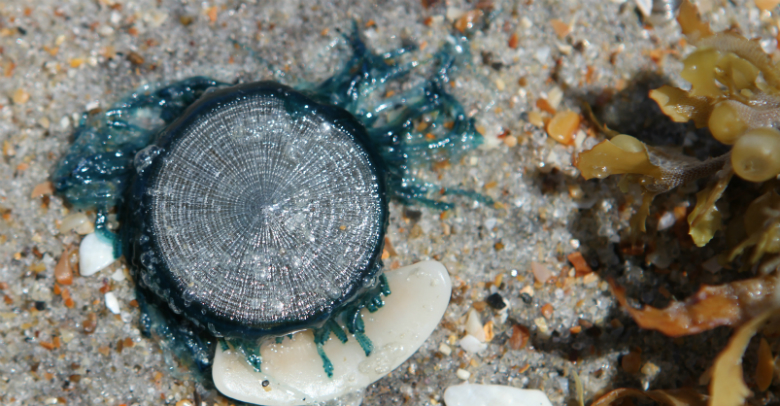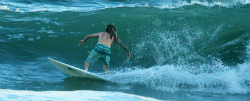 A blue button next to a white seashell and sargassum seaweed for scale. The blue button is a colony of organisms that usually live well out to sea on the surface of the ocean. Photo: Sam Bland A blue button next to a white seashell and sargassum seaweed for scale. The blue button is a colony of organisms that usually live well out to sea on the surface of the ocean. Photo: Sam Bland |
EMERALD ISLE — Awaking before dawn, on this early August morning, I could hear the pulse of the ocean even though my house was closed tight with the air conditioner humming to seal out the sultry dog days of summer.
For years, I thought that the term referred to lazy canines rendered sluggish by the oppressive summer sun. But the dog days are actually a reference to the constellation of Canis Major, or great dog, and specifically to Sirius, the alpha Dog Star and brightest star in the night sky. Canis Major was the big hunting dog belonging to Orion, the great hunter of Greek mythology. During part of the summer, Sirius rises with the sun. Because of this, ancients once thought that Sirius heated up the sun even more causing blistering hot days during July and August that became known as the dog days of summer.
Supporter Spotlight
 As Bland combed the beach for unusual finds, surfers trotted into the ocean, eager to quench their thirst with head-high waves. Photo: Sam Bland |
The roar of the sea, filtering through the closed windows, impaled me like a harpoon and pulled me to the shore as if I didn’t have any choice. On the ocean side of the dunes, a ghost crab peered from its burrow then melted back into the sand giving honor to its name. As I stepped out onto the open beach, I could feel the vibrations of the pounding waves coursing through the sand. The swells were undulating across the surface of the ocean like the ripples on a sail luffing in the wind. The sound was a constant mixture of individual crashing waves that meshed together like the white noise found on a sleep machine. Waves that traveled across a vast ocean, carried and now released the voice of a hurricane well out to sea.
Storms are a beachcomber’s ally, a philanthropist depositing gifts and curiosities along a beach strewn with seaweed and chunks of airy foam. I rambled along the beach looking for calcium carbonite trophies, of which there were a few. Some nice whelks and helmet shells would quickly be snatched up as soon as the sleepy tourist, sipping their coffee, began their morning at the edge of the sea. I resisted the urge to pick up shells, instead intent on finding the unusual. It didn’t take long as I double stepped to prevent myself from trampling on a bluish gray disk-shaped object complete with teal colored tassels. But this was not a seashell, or even an animal, it was a colony of animals.
This group of organisms, which is related to jellyfish, is known as a blue button. The object, which looks like it could be a colorful brooch pinned to the lapel of a jacket, is a group of hydroid polyps that usually live well out to sea on the surface of the ocean. Each animal in the colony has a specific function such as reproduction, feeding or protection. The sturdy one-and-a-half-inch round disk is filled with gas which creates buoyancy. Trailing underneath the disk are numerous tentacle-like strands of hydroids. At the ends of the tentacles are powerful stinging cells called nematocysts. Inside each cell is a coiled harpoon-like spear that is launched when water pressure enters the cell. These spears are used to deter predators and to capture prey such as crab larvae. Lacking any form of propulsion, these animals wander the ocean at the pleasure of the wind, the waves and the currents.
 Unlike the blue button, sea pansies live on the ocean floor and are anchored into the sand or mud by the peduncle. Photo: Sam Bland |
Not far from the blue button, I found another similar object partially buried in the sand. This purplish two-inch, fleshy looking item, called a sea pansy, resembled a mushroom or even the petal of a flower. It is a type of soft coral that is also a collection of individual organisms that work cooperatively at different tasks to benefit the group as a whole. The leaf-like body is connected to stalk called a peduncle. Unlike the blue button, sea pansies live on the ocean floor and are anchored into the sand or mud by the peduncle. Even if uprooted by rough seas the peduncle can establish a new mooring once it settles back onto the sand.
The fleshy body has a firm and rigid structure thanks to needle-like objects called spicules. On the upper side of the body are two kinds of polyps. One feeds by trapping plankton in gooey mucus. The other controls water that enters the body, allowing it to inflate or deflate as necessary. If exposed at low tide, the sea pansy will deflate the body allowing it to be covered by sand and hidden from predators.
When exposed during the night, the sea pansy can also thwart predators by distracting them with an amazing show of pulsating waves of green light. A green fluorescent protein along with an enzyme creates this bioluminescent activity when the body is touched or molested by an aggressive predator. Interestingly, the enzyme is known as a luciferase, from the word lucifer, which means “light bearer.” As I handled the sea pansy in the daylight I was unable to detect any display of the bioluminescence. Intently studying the creature, I was unaware that I was now surrounded by serious beachcombers scavenging the beach for vacation mementos. I walked off as a group of giddy surfers trotted into the surf, eager to quench their thirst with head-high waves that ended a long drought of rideable waves.







